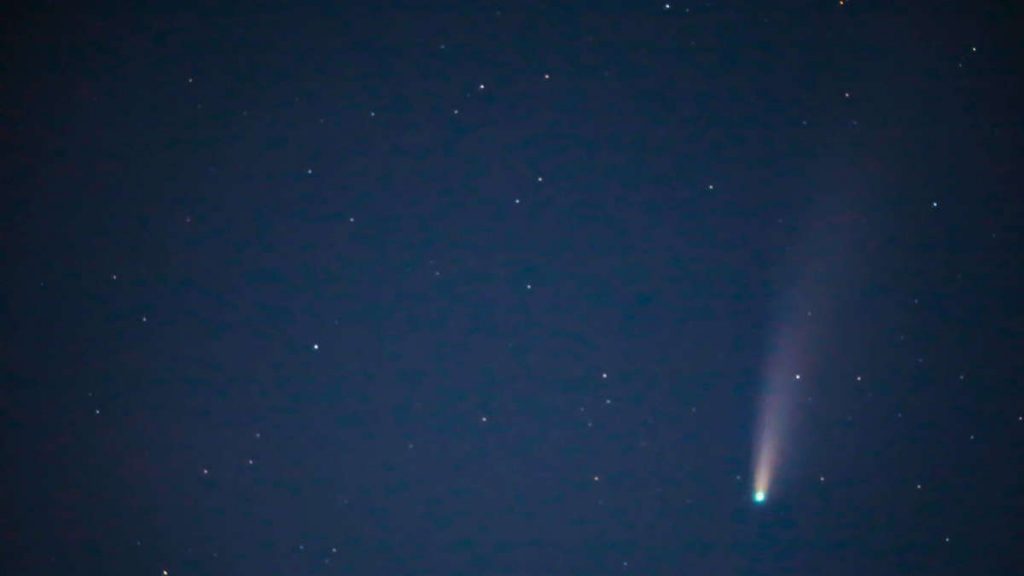-
fromTanya Banner
Close
Winter astronomy highlight: Comet Leonard (C/2021 A1) can be seen with the naked eye in November and December. What you need to know
Frankfurt – a comet that can be seen in the sky with the naked eye does not happen very often. In recent years, only one comet has fallen midway into this category: Comet Neues (C/2020 F3) was visible to the naked eye for some time in the summer of 2020 and under very dark skies. But there may soon be a successor: Comet Leonard (C/2021 A1) Currently astronomers are watching it closely – it will likely become bright enough. But you should not rejoice early – because it is very difficult to assess the behavior of comets.
Comet Leonard was the first comet to be discovered in 2021: it was first spotted on January 3, 2021 by astronomer Greg J. Leonard at the Mount Lemon Observatory in Tucson, Arizona. At that time, the comet was about 750 million kilometers from the Sun. On January 3, 2022, its path will be closest to the Sun, known as perihelion. Then Leonard is about 92.2 million km from the Sun. It already has its closest approach to Earth: NASA estimates that Comet Leonard will approach Earth on December 12, 2021 at about 2:54 p.m. German time — at a safe distance of approximately 35 million kilometers.
c / 2021 a 1 leonard 2021 nov. 7 Output 3.38 5x4min 11″ RACE Nikon Z6mod Michael Jäger pic.twitter.com/nNWiIIbteK
– Michael Jager (@Komet123Jager) November 7, 2021
Comet Leonard (C / 2021 A1) can be seen with the naked eye in November / December 2021
The brightness of Comet Leonard will appear in November and December 2021 with the passage of time. According to estimates by the “EarthSky” portal, the brightness is assumed to be between 5 and 2.6. The lower this value, the brighter the object can be seen. But comets’ behavior is generally considered unpredictable, which makes it very difficult to predict how Leonard’s comet’s brightness will evolve. For example, Comet Atlas was considered a hopeful in 2020 – and it broke before it could make a show in the sky. Something similar happened to Comet Ison in 2013, which broke apart on its closest approach to the sun.
| Noun | C / 2021 A1 Leonard |
| spiral stars | comet |
| Discovery | January 3, 2021 By Greg J. Leonard |
| perihelion (closest approach to the sun) | 0.6151 AU am 3.01.2022 |
| Closest approach to Earth | 0.233 AU am 12.12.2021 |
How to find Comet Leonard in the night sky
If Comet Leonard becomes visible to the naked eye, it will be seen first in the Northern Hemisphere, and then in the Southern Hemisphere. The comet is traveling at 254,412 kilometers per hour – but you won’t see it “racing” across the sky, since Leonard is very far from Earth. One thing is for sure: if you want to see a comet in the sky, you have to look for it early in the morning. Around mid-November, Comet Leonard wanders into the constellation “Haar der Berenike,” which rises around 1.30 a.m. in the east. On December 2, the comet can be seen near the globular cluster M3, and then moves toward the bright star Arctur in the constellation Bear Guardian.
Specialized magazine “Sky & Telescope” estimates that the comet may reach 10 degrees in mid-November – a brightness that cannot be seen with the naked eye, but can already be seen with smaller telescopes. About the time Comet Leonard is near the star Arcturus, it can reach a magnitude of 5.5 degrees and thus become something faintly perceptible to the naked eye. In the Northern Hemisphere, you can peek at the comet in the morning sky on December 12, 2021 — shortly before its theoretical maximum brightness. It will then be visible low in the southwest sky at dusk. Observers in the Southern Hemisphere now have the opportunity to look at the comet.
Comets are “dirty snowballs” from the depths of space
Comets come from the depths of space and are made up of dust and rocks that are held together by ice. When a comet approaches the Sun, the ice melts and dust and stones are liberated – the comet’s characteristic tail is formed. This is exactly what makes predicting the brightness of Leonard’s Comet (C / 2021 A1) so difficult: no one can predict exactly how the comet will behave in the increasing heat – it will become more energetic, but how active? No one can reliably expect that at the moment.
Comets – nickname: “cosmic snowballs” – are of particular interest to research because they are considered messengers from the depths of the universe. According to NASA’s calculations, Comet Leonard came from the outer solar system and moved more than 550 billion km toward the center of the solar system 40,000 years ago. After reaching perihelion, according to NASA, it will likely be expelled from the solar system. So winter 2021/22 is your last chance to see Comet Leonard.
Only recently, two researchers accidentally discovered the largest comet known to date. It is on its way towards the center of the solar system, in the year 2031 it should reach its point closest to the sun. (tab)

“Social media evangelist. Baconaholic. Devoted reader. Twitter scholar. Avid coffee trailblazer.”









More Stories
Longest jets in the universe discovered – giant particle streams as long as 140 Milky Way galaxies in a row
New method reveals 307 supernova remnants
Snapchat is upping the ante on augmented reality glasses